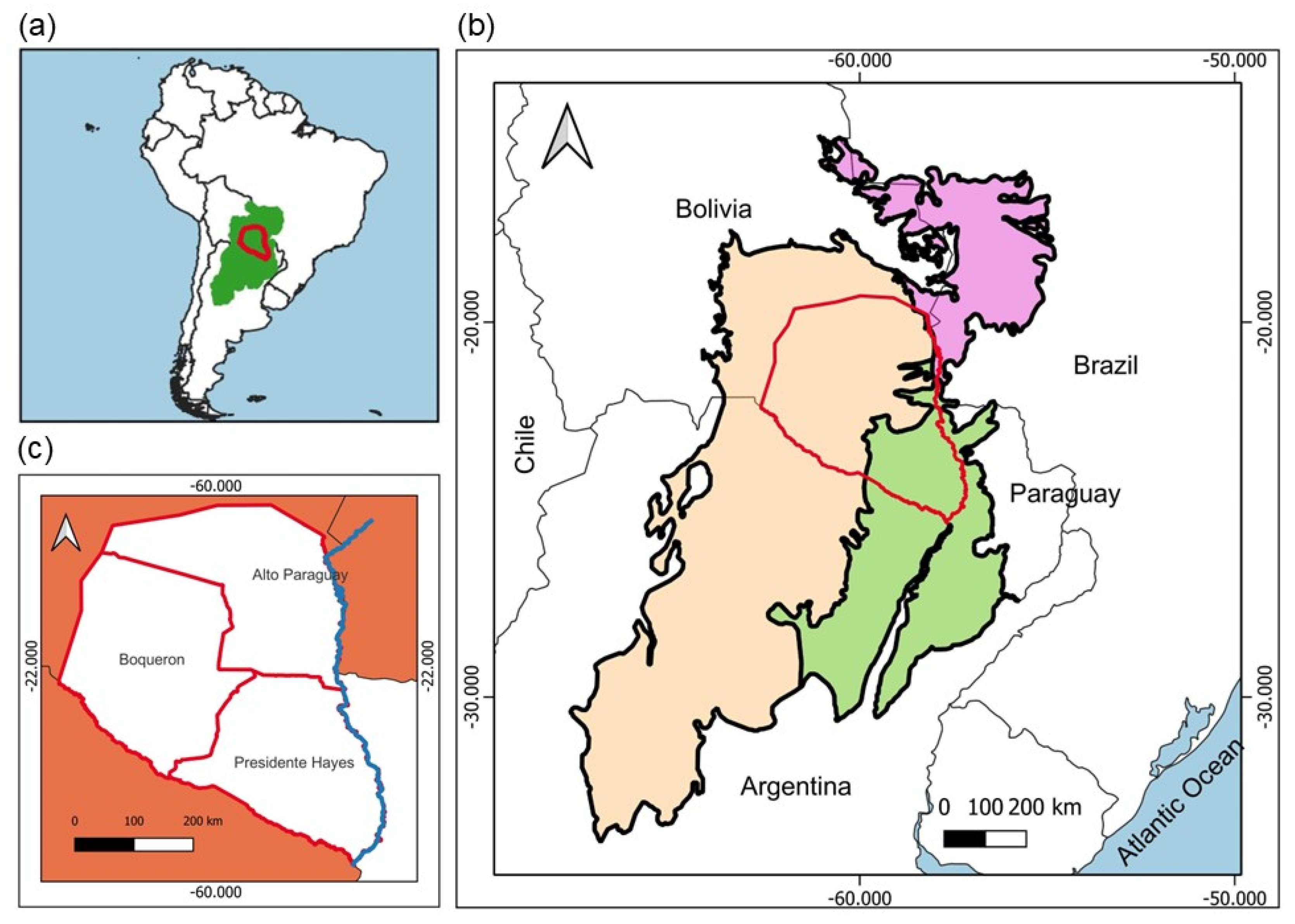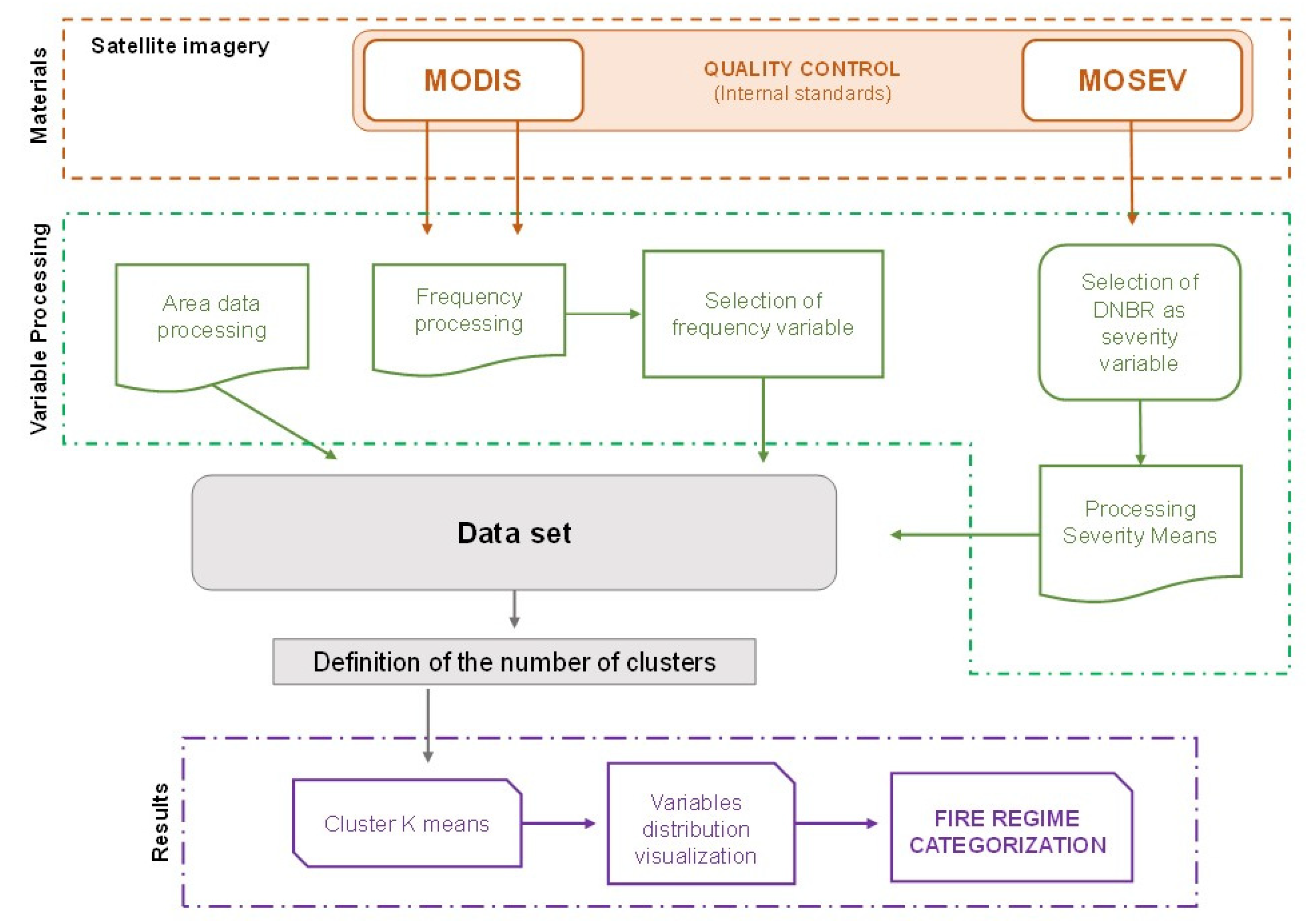Assessing Fire Regimes in the Paraguayan Chaco: Implications for Ecological and Fire Management
Abstract
1. Introduction
2. Materials and Methods
2.1. Description of Study Area
2.2. Data Collection and Remote Sensing Products
2.3. Data Quality Control
2.4. Fire Regime Characterization
3. Results
4. Discussion
5. Conclusions
Author Contributions
Funding
Institutional Review Board Statement
Informed Consent Statement
Data Availability Statement
Acknowledgments
Conflicts of Interest
References
- Bowman, D.M.J.S.; Murphy, B.P.; Williamson, G.J.; Cochrane, M.A. Pyrogeographic Models, Feedbacks and the Future of Global Fire Regimes. Glob. Ecol. Biogeogr. 2014, 23, 821–824. [Google Scholar] [CrossRef]
- Morgan, P.; Hardy, C.; Swetnam, T.; Rollins, M.; Long, D. Mapping Fire Regimes across Time and Space: Understanding Coarse and Fine-Scale Fire Patterns. Int. J. Wildland Fire 2001, 10, 329–342. [Google Scholar] [CrossRef]
- van Wagtendonk, J.; Lutz, J. Fire Regime Attributes of Wildland Fires in Yosemite National Park, USA. Fire Ecol. 2007, 3, 34–52. [Google Scholar] [CrossRef]
- Fernández, V.; Quintano, C.; Taboada, A.; Marcos, E.; Calvo, L.; Fernandez-manso, A. Remote Sensing Applied to the Study of Fire Regime Attributes and Their Influence on Post-Fire Greenness Recovery in Pine Ecosystems. Remote Sens. 2018, 10, 733. [Google Scholar] [CrossRef]
- Bond, W.; Keeley, J. Fire as a Global ‘Herbivore’: The Ecology and Evolution of Flammable Ecosystems. Trends Ecol. Evol. 2005, 20, 387–394. [Google Scholar] [CrossRef]
- Lentile, L.; Holden, Z.; Smith, A.; Falkowski, M.; Hudak, A.; Morgan, P.; Lewis, S.; Gessler, P.; Benson, N. Remote Sensing Techniques to Assess Active Fire Characteristics and Post-Fire Effects. Int. J. Wildland Fire 2006, 15, 319–345. [Google Scholar] [CrossRef]
- Bowman, D.M.J.S.; Kolden, C.A.; Abatzoglou, J.T.; Johnston, F.H.; van der Werf, G.R.; Flannigan, M. Vegetation Fires in the Anthropocene. Nat. Rev. Earth Environ. 2020, 1, 500–515. [Google Scholar] [CrossRef]
- Estes, B.L.; Knapp, E.E.; Skinner, C.N.; Miller, J.D.; Preisler, H.K. Factors Influencing Fire Severity under Moderate Burning Conditions in the Klamath Mountains, Northern California, USA. Ecosphere 2017, 8, e01794. [Google Scholar] [CrossRef]
- Veraverbeke, S.; Lhermitte, S.; Verstraeten, W.W.; Goossens, R. The Temporal Dimension of Differenced Normalized Burn Ratio (dNBR) Fire/Burn Severity Studies: The Case of the Large 2007 Peloponnese Wildfires in Greece. Remote Sens. Environ. 2010, 114, 2548–2563. [Google Scholar] [CrossRef]
- Harris, L.; Taylor, A.H. Topography, Fuels, and Fire Exclusion Drive Fire Severity of the Rim Fire in an Old-Growth Mixed-Conifer Forest, Yosemite National Park, USA. Ecosystems 2015, 18, 1192–1208. [Google Scholar] [CrossRef]
- Miller, R.G.; Tangney, R.; Enright, N.J.; Fontaine, J.B.; Merritt, D.J.; Ooi, M.K.J.; Ruthrof, K.X.; Miller, B.P. Fire Seasonality Mechanisms Are Fundamental for Understanding Broader Fire Regime Effects. Trends Ecol. Evol. 2020, 35, 869–871. [Google Scholar] [CrossRef] [PubMed]
- Collins, L.; Bennett, A.F.; Leonard, S.W.J.; Penman, T.D. Wildfire Refugia in Forests: Severe Fire Weather and Drought Mute the Influence of Topography and Fuel Age. Glob. Chang. Biol. 2019, 25, 3829–3843. [Google Scholar] [CrossRef]
- García, M.; Pettinari, M.L.; Chuvieco, E.; Salas, J.; Mouillot, F.; Chen, W.; Aguado, I. Characterizing Global Fire Regimes from Satellite-Derived Products. Forests 2022, 13, 699. [Google Scholar] [CrossRef]
- Galizia, L.F.; Curt, T.; Barbero, R.; Rodrigues, M. Understanding Fire Regimes in Europe. Int. J. Wildland Fire 2021, 31, 56–66. [Google Scholar] [CrossRef]
- San-Miguel-Ayanz, J.; Rodrigues, M.; Oliveira, S.; Kemper Pacheco, C.; Moreira, F.; Duguy, B.; Camia, A. Land Cover Change and Fire Regime in the European Mediterranean Region. In Post-Fire Mangement and Restoration of Southern European Forests-Managing Forest Ecosystems; Springer: Berlin/Heidelberg, Germany, 2012; pp. 21–43. ISBN 978-94-007-2208-8. [Google Scholar]
- Parks, S.; Holsinger, L.; Miller, C.; Parisien, M.-A. Analog-Based Fire Regime and Vegetation Shifts in Mountainous Regions of the Western US. Ecography 2018, 41, 910–921. [Google Scholar] [CrossRef]
- Murphy, B.; Bradstock, R.; Boer, M.; Carter, J.; Cary, G.; Cochrane, M.; Fensham, R.; Russell-Smith, J.; Williamson, G.; Bowman, D. Fire Regimes of Australia: A Pyrogeographic Model System. J. Biogeogr. 2013, 40, 1048–1058. [Google Scholar] [CrossRef]
- de la Barrera, F.; Barraza, F.; Favier, P.; Ruiz, V.; Quense, J. Megafires in Chile 2017: Monitoring Multiscale Environmental Impacts of Burned Ecosystems. Sci. Total Environ. 2018, 637–638, 1526–1536. [Google Scholar] [CrossRef] [PubMed]
- Júnior, A.C.P.; Oliveira, S.L.J.; Pereira, J.M.C.; Turkman, M.A.A. Modelling Fire Frequency in a Cerrado Savanna Protected Area. PLoS ONE 2014, 9, e102380. [Google Scholar] [CrossRef]
- San Martín, R.; Ottlé, C.; Sörensson, A. Fires in the South American Chaco, from Dry Forests to Wetlands: Response to Climate Depends on Land Cover. Fire Ecol. 2023, 19, 57. [Google Scholar] [CrossRef]
- Vidal-Riveros, C.; Souza-Alonso, P.; Bravo, S.; Laino, R.; Ngo Bieng, M.A. A Review of Wildfires Effects across the Gran Chaco Region. For. Ecol. Manag. 2023, 549, 121432. [Google Scholar] [CrossRef]
- Bilbao, B.; Steil, L.; Urbieta, I.R.; Anderson, L.; Pinto, C.; Gonzalez, M.E.; Millán, A.; Falleiro, R.M.; Morici, E.; Ibarnegaray, V.; et al. Incendios forestales. In Adaptación Frente a Los Riesgos Del Cambio Climático en Los Países Iberoamericanos—Informe RIOCCADAPT; Moreno, J.M., Laguna-Defior, C., Barros, V., Calvo Buendía, E., Marengo, J.A., Oswald Spring, U., Eds.; McGraw-Hill: Madrid, Spain, 2020; pp. 459–524. ISBN 9788448621643. [Google Scholar]
- Dinerstein, E.; Olson, D.; Joshi, A.; Vynne, C.; Burgess, N.; Wikramanayake, E.; Hahn, N.; Palminteri, S.; Hedao, P.; Noss, R.; et al. An Ecoregion-Based Approach to Protecting Half the Terrestrial Realm. BioScience 2017, 1, 534–545. [Google Scholar] [CrossRef]
- Baumann, M.; Levers, C.; Macchi, L.; Bluhm, H.; Waske, B.; Gasparri, N.I.; Kuemmerle, T. Mapping Continuous Fields of Tree and Shrub Cover across the Gran Chaco Using Landsat 8 and Sentinel-1 Data. Remote Sens. Environ. 2018, 216, 201–211. [Google Scholar] [CrossRef]
- Campos Krauer, J.; Wisely, S. Deforestation and Cattle Ranching Drive Rapid Range Expansion of Capybara in the Gran Chaco Ecosystem. Glob. Chang. Biol. 2010, 17, 206–218. [Google Scholar] [CrossRef]
- Caldas, M.M.; Goodin, D.; Sherwood, S.; Campos Krauer, J.M.; Wisely, S.M. Land-Cover Change in the Paraguayan Chaco: 2000–2011. J. Land Use Sci. 2015, 10, 1–18. [Google Scholar] [CrossRef]
- Gill, A.; Canova, E.; Insfrán, P.; Gonzalez, R. Atlas del Chaco Paraguayo/Atlas of the Paraguayan Chaco; WWF: Asunción, Paraguay; DLR: Cologne, Germany, 2020; ISBN 978-99967-792-3-7. [Google Scholar]
- Baumann, M.; Piquer-Rodríguez, M.; Fehlenberg, V.; Gavier Pizarro, G.; Kuemmerle, T. Land-Use Competition in the South American Chaco. In Land Use Competition. Human-Environment Interactions; Niewöhner, J., Bruns, A., Hostert, P., Krueger, T., Nielsen, J.Ø., Haberl, H., Lauk, C., Lutz, J., Müller, D., Eds.; Springer: Cham, Switzerland, 2016; pp. 215–229. [Google Scholar] [CrossRef]
- Kunst, C.; Ledesma, R.; Navarrete, V. Fire Behavior in an Ecotonal Grassland of the Chaco Region, Argentina. Rev. Investig. Agropecu. RIA 2012, 38, 4–9. [Google Scholar] [CrossRef]
- Ibañez Moro, A.V.; Bravo, S.J.; Abdala, N.R.; Borghetti, F.; Chaib, A.M.; Galetto, L. Heat Shock Effects on Germination and Seed Survival of Five Woody Species from the Chaco Region. Flora 2021, 275, 151751. [Google Scholar] [CrossRef]
- Kunst, C.; Bravo, S.; Ledesma, R.; Navall, M.; Anríquez, A.; Coria, R.D.; Silberman, J.; Gómez, A.; Albanesi, A. Ecology and Management of the Dry Forests and Savannas of the Western Chaco Region, Argentina. In Dry forest; Nova Science Publishers, Inc.: Hauppauge, NY, USA, 2014; pp. 133–164. ISBN 978-1-63321-291-6. [Google Scholar]
- Giglio, L.; van der Werf, G.R.; Randerson, J.T.; Collatz, G.J.; Kasibhatla, P. Global Estimation of Burned Area Using MODIS Active Fire Observations. Atmos. Chem. Phys. 2006, 6, 957–974. [Google Scholar] [CrossRef]
- Landi, M.; Di Bella, C.; Ojeda, S.; Salvatierra, P.; Arganaraz, J.; Bellis, L. Selecting Control Sites for Post-Fire Ecological Studies Using Biological Criteria and MODIS Time Series Data. Fire Ecol. 2017, 13, 1–17. [Google Scholar] [CrossRef]
- Maillard, O.; Herzog, S.K.; Soria-Auza, R.W.; Vides-Almonacid, R. Impact of Fires on Key Biodiversity Areas (KBAs) and Priority Bird Species for Conservation in Bolivia. Fire 2022, 5, 4. [Google Scholar] [CrossRef]
- Silva, P.; Nogueira, J.; Rodrigues, J.; Lemos, F.; Pereira, J.; Dacamara, C.; Daldegan, G.; Pereira, A.; Peres, L.; Schmidt, I.; et al. Putting Fire on the Map of Brazilian Savanna Ecoregions. J. Environ. Manag. 2021, 296, 113098. [Google Scholar] [CrossRef]
- Alonso-González, E.; Fernández-García, V. MOSEV: A Global Burn Severity Database from MODIS (2000–2020). Earth Syst. Sci. Data 2021, 13, 1925–1938. [Google Scholar] [CrossRef]
- Wu, X.; Kumar, V.; Quinlan, R.; Ghosh, J.; Yang, Q.; Motoda, H.; Mclachlan, G.; Ng, S.K.A.; Liu, B.; Yu, P.; et al. Top 10 Algorithms in Data Mining. Knowl. Inf. Syst. 2007, 14, 1–37. [Google Scholar] [CrossRef]
- Archibald, S.; Lehmann, C.; Gomez-Dans, J.; Bradstock, R. Defining Pyromes and Global Syndromes of Fire Regimes. In Proceedings of the National Academy of Sciences of the United States of America 2013, Washington, DC, USA, 20 August 2013. [Google Scholar] [CrossRef]
- Mereles, M.; Rodas, O. Assessment of Rates of Deforestation Classes in the Paraguayan Chaco (Great South American Chaco) with Comments on the Vulnerability of Forests Fragments to Climate Change. Clim. Chang. 2014, 127, 55–71. [Google Scholar] [CrossRef]
- Negri Bernardino, P.; Dantas, V.; Hirota, M.; Pausas, J.; Oliveira, R. Savanna–Forest Coexistence Across a Fire Gradient. Ecosystems 2021, 25, 279–290. [Google Scholar] [CrossRef]
- Damasceno-Junior, G. Lessons to Be Learned from the Wildfire Catastrophe of 2020 in the Pantanal Wetland. Wetl. Sci. Pract. WSP 2021, 38, 107–115. [Google Scholar] [CrossRef]
- Teodoro, P.E.; Maria, L.D.S.; Rodrigues, J.M.A.; Silva, A.D.A.E.; Silva, M.C.M.D.; Souza, S.S.D.; Rossi, F.S.; Teodoro, L.P.R.; Della-Silva, J.L.; Delgado, R.C.; et al. Wildfire Incidence throughout the Brazilian Pantanal Is Driven by Local Climate Rather Than Bovine Stocking Density. Sustainability 2022, 14, 10187. [Google Scholar] [CrossRef]
- Menezes, L.S.; de Oliveira, A.M.; Santos, F.L.M.; Russo, A.; de Souza, R.A.F.; Roque, F.O.; Libonati, R. Lightning Patterns in the Pantanal: Untangling Natural and Anthropogenic-Induced Wildfires. Sci. Total Environ. 2022, 820, 153021. [Google Scholar] [CrossRef] [PubMed]
- McLauchlan, K.K.; Higuera, P.E.; Miesel, J.; Rogers, B.M.; Schweitzer, J.; Shuman, J.K.; Tepley, A.J.; Varner, J.M.; Veblen, T.T.; Adalsteinsson, S.A.; et al. Fire as a Fundamental Ecological Process: Research Advances and Frontiers. J. Ecol. 2020, 108, 2047–2069. [Google Scholar] [CrossRef]
- Müller, S.C.; Overbeck, G.E.; Pfadenhauer, J.; Pillar, V.D. Plant Functional Types of Woody Species Related to Fire Disturbance in Forest–Grassland Ecotones. Plant Ecol. 2007, 189, 1–14. [Google Scholar] [CrossRef]
- Pellegrini, A.F.A.; Ahlström, A.; Hobbie, S.E.; Reich, P.B.; Nieradzik, L.P.; Staver, A.C.; Scharenbroch, B.C.; Jumpponen, A.; Anderegg, W.R.L.; Randerson, J.T.; et al. Fire Frequency Drives Decadal Changes in Soil Carbon and Nitrogen and Ecosystem Productivity. Nature 2018, 553, 194–198. [Google Scholar] [CrossRef] [PubMed]
- Rogers, B.M.; Veraverbeke, S.; Azzari, G.; Czimczik, C.I.; Holden, S.R.; Mouteva, G.O.; Sedano, F.; Treseder, K.K.; Randerson, J.T. Quantifying Fire-Wide Carbon Emissions in Interior Alaska Using Field Measurements and Landsat Imagery. J. Geophys. Res. Biogeosci. 2014, 119, 1608–1629. [Google Scholar] [CrossRef]




Disclaimer/Publisher’s Note: The statements, opinions and data contained in all publications are solely those of the individual author(s) and contributor(s) and not of MDPI and/or the editor(s). MDPI and/or the editor(s) disclaim responsibility for any injury to people or property resulting from any ideas, methods, instructions or products referred to in the content. |
© 2024 by the authors. Licensee MDPI, Basel, Switzerland. This article is an open access article distributed under the terms and conditions of the Creative Commons Attribution (CC BY) license (https://creativecommons.org/licenses/by/4.0/).
Share and Cite
Vidal-Riveros, C.; Watler Reyes, W.J.; Ngo Bieng, M.A.; Souza-Alonso, P. Assessing Fire Regimes in the Paraguayan Chaco: Implications for Ecological and Fire Management. Fire 2024, 7, 347. https://doi.org/10.3390/fire7100347
Vidal-Riveros C, Watler Reyes WJ, Ngo Bieng MA, Souza-Alonso P. Assessing Fire Regimes in the Paraguayan Chaco: Implications for Ecological and Fire Management. Fire. 2024; 7(10):347. https://doi.org/10.3390/fire7100347
Chicago/Turabian StyleVidal-Riveros, Cristina, William Jefferson Watler Reyes, Marie Ange Ngo Bieng, and Pablo Souza-Alonso. 2024. "Assessing Fire Regimes in the Paraguayan Chaco: Implications for Ecological and Fire Management" Fire 7, no. 10: 347. https://doi.org/10.3390/fire7100347
APA StyleVidal-Riveros, C., Watler Reyes, W. J., Ngo Bieng, M. A., & Souza-Alonso, P. (2024). Assessing Fire Regimes in the Paraguayan Chaco: Implications for Ecological and Fire Management. Fire, 7(10), 347. https://doi.org/10.3390/fire7100347





